7 Types of Clutterholic
7 Types of Clutterholic
Did you know there are different types of clutterholics?
You are not alone.
Many people think that if you’re not as bad as the people you see on TV decluttering programmes – the hoarders – then your clutter isn’t that bad.
When I had my clutter challenge and overcame it in 2001 I started helping other clutterholics to clear their clutter by sharing the process I had used.
I started to notice that not all clutterholics were the same.
Of course everyone’s clutter was unique to them – some had mainly paperwork clutter, some had mainly clothes clutter, some had mainly sentimental clutter, hoarders usually had a mixture of everything.
I noticed that people contacting me for help usually compared themselves to the cases you see on the TV Programmes – the hoarders and, because they didn’t think they were that bad, had put off dealing with their clutter until it reached a point where they felt they were heading towards becoming a hoarder.
So I started to look closer and identified 7 types of clutterholic along a sliding scale.
We call it the Clutter Clearing Severity Slide because the further along the scale you go the closer to being a hoarder you are. Here are brief descriptions of each type – be aware that you will not exactly match every aspect of each description – look for the one that has the greatest number of characteristics that reflect your clutter challenges and experiences. See which one sounds most with you.
1. Secret Clutterholic
You are like 9% of my clients since 2001
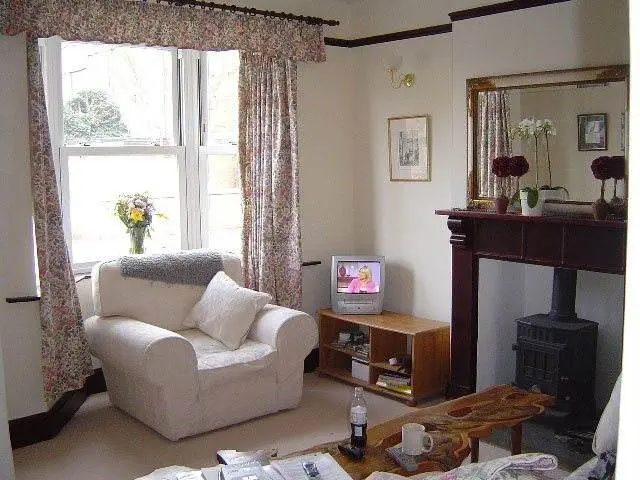
A Secret Clutterholic can easily be mistaken for someone who doesn’t have a clutter challenge because they are experts at hiding their clutter.
For clutterholics and hoarders, this would be an uncluttered home and an unrealistic level of clutter free to try to work towards.
What you will see:
You won’t see visible signs of clutter in their home – it will all be hidden in drawers, cupboards, rooms, attics and sheds that you won’t go into.
How much clutter?
Less than 25% – surfaces, drawers, under furniture, cupboards are stuffed and disorganised.
What their friends and family will see:
They won’t know they have a clutter problem because it’s all hidden.
They believe their biggest problem with dealing with their clutter is:
Lack of time
Where most of the clutter comes from:
Grocery Shopping: once a week with a list and stick to the list. General Shopping: when they need to but without a list and impulse buy things.
Why they may be disorganised:
Most things have a clearly defined home and generally gets put away more than once a week.
Why they struggle with keeping areas clear of clutter:
They keep on top of it by usually have a regular weekly routine for doing household chores and cleaning.
Paperwork Clutter:
They often have a routine for checking their post and paperwork
Financial Clutter:
They often have a routine of checking their financial paperwork against their shopping receipts every month, shredding or burning the receipts once checked, and are aware of their monthly financial situation and what they spend their money on.
What they want:
They are unlikely to think that they have a clutter challenge.
What they are likely to say about their clutter:
I just need to find some time to have a sort through things.
How they often feel about their clutter:
They don’t think it’s clutter, they think they just need to go through their stuff.
The most common type of clutter they have:
Impulse Purchases
The most common type of help they try before coming to Clutter Clearing:
None
Will the 7 Step Clutter Clearing Programme Help?
No – this is not considered a Clutter Challenge.
How long does it usually take them to Clear their Clutter?
Not applicable.
2. Mild Clutterholic
You are like 12% of Clare’s clients since 2001.

A Mild Clutterholic can often be mistaken for someone who is simply untidy.
The name comes from they fact that they have hidden clutter like the secret clutterholic, and also some visible clutter which is usually paper related, piles on surfaces and/or boxes.
For clutterholics and hoarders, this would be an uncluttered home and may be a realistic level of acceptable clutter to work towards.
What you will see:
Clutter mainly confined to one room.
How much clutter?
Approximately 25% – surfaces, drawers, under furniture, cupboards stuffed and disorganised, starting to appear in piles of the floor.
What their friends and family will see:
They won’t know they have a clutter problem because it’s confined to one room and that visitors don’t see.
They believe their biggest problem with dealing with their clutter is:
Lack of time and lack of storage space.
Where most of the clutter comes from:
Grocery Shopping: They go grocery shopping once a week and stick to a list General Shopping: They go about once a month without a list and impulse buy things
Why they may be disorganised:
Most things have a clearly defined home and generally gets put away more every couple of weeks.
Why they struggle with keeping areas clear of clutter:
They may not have a regular weekly routine for doing household chores and cleaning.
Paperwork Clutter:
They probably have a routine for opening their post and dealing with their paperwork
Financial Clutter:
They often have a routine of checking their financial paperwork against their shopping receipts every month, but don’t check every receipt against their statements and are aware of their monthly financial situation and what they spend their money on.
What they want:
They believe they just need time or storage solutions to deal with their clutter.
What they are likely to say about their clutter:
It’s not that bad, it won’t take me long to sort out.
How they often feel about their clutter:
They usually feel guilty for being a bit cluttered, even though it may only be a relatively small amount of clutter.
The most common type of clutter they have:
Impulse Purchases, BOGOF offers, ‘bargains’, paperwork
The most common type of help they try before coming to Clutter Clearing:
Storage and Organisational Expert
Will the 7 Step Clutter Clearing Programme Help?
Yes – Step 1 and 2 to help get into a routine of controlling and maintaining
How much of the persons time will it take?
Step 1 = 1 half day a week
Step 2 = 2 half days a week
How long does it usually take them to Clear their Clutter?
3 months
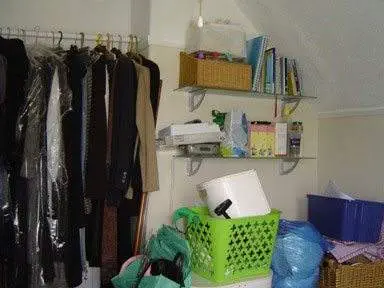
3. Comfort Clutterholic
You are like 16% of Clare’s clients since 2001
A Comfort Clutterholic can often be mistaken for a Secret or Mild Clutterholic.
The name comes from people who give the appearance of being comfortable in their homes (while there are actually one or two areas that they struggle to control), and the fact that they take comfort either through frequent shopping, or by holding onto sentimental items from the past.
What you will see:
Clutter mainly in confined to a couple of rooms.
How much clutter?
25% – 50% – surfaces, drawers, under furniture, cupboards stuffed and disorganised, all over the floor, all surfaces and to knee height.
What their friends and family will see:
They won’t know they have a clutter problem because it’s confined to one room and that visitors don’t see.
They believe their biggest problem with dealing with their clutter is:
Lack of time, lack of storage space and lack of organisation.
Where most of the clutter comes from:
Grocery and online / impulse Shopping: They go grocery shopping once a week but don’t stick to a list General Shopping: They go about once a week without a list and impulse buy things
Why they may be disorganised:
Most things have a clearly defined home and there’s a big tidy up on average once a month.
Why they struggle with keeping areas clear of clutter:
They do things like household cleaning regularly on the rooms that aren’t cluttered, and only on the room if they need to find something or have visitors.
Paperwork Clutter:
They probably open their post most days and deal with paperwork a couple of times a month.
Financial Clutter:
They sometimes have a routine of checking their financial paperwork against their shopping receipts every few month, but don’t check every receipt against their statements and are have a rough idea of their monthly financial situation and what they spend their money on.
What they want:
They believe they just need help to get organised.
What they are likely to say about their clutter:
I just need the right storage solution / to get organised and then it’ll all be OK and I can keep it clutter free.
How they often feel about their clutter:
Their clutter represents safety
The most common type of clutter they have:
Impulse Purchases, BOGOF offers, ‘bargains’, paperwork, information, sentimental
The most common type of help they try before coming to Clutter Clearing:
Storage and Organisational Expert
Will the 7 Step Clutter Clearing Programme Help?
Yes – Step 1, 2, 3 and 4 to help get into a routine of controlling and maintaining their conveyor belt and clear the backlog
How much of the persons time will it take?
Step 1 = 1 hour 2 days a week
Step 2 = 1 hour 5 days a week
Step 3 = 1 hour 5 days a week
How long does it usually take them to Clear their Clutter?
6 months
4. Habitual Clutterholic
You are like 36% of Clare’s clients since 2001
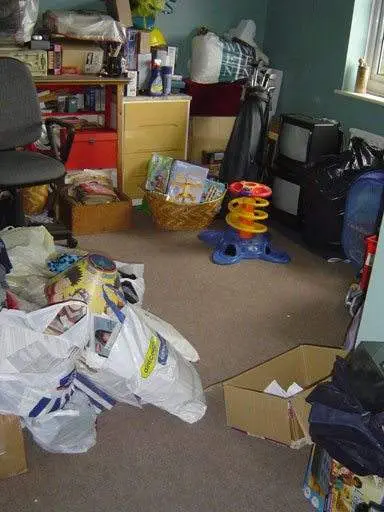
A Habitual clutterholic is so named because their clutter is a habit that is so ingrained that it takes a significant amount of time and effort to deal with the clutter.
What you will see:
Clutter in 3 or more rooms.
How much clutter?
50% – surfaces, drawers, under furniture, cupboards stuffed and disorganised, all over the floor, all surfaces and to above knee height.
What their friends and family will see:
They will be aware that they have a clutter problem because some of it will be visible in the rooms they see.
They believe their biggest problem with dealing with their clutter is:
Lack of time, lack of storage space and lack of organisation, difficulty in making decisions, support.
Where most of the clutter comes from:
Grocery Shopping: They go grocery shopping more than once a week but don’t stick to a list General Shopping: They go about once a week without a list and impulse buy things they don’t need or use
Online Shopping: They will surf the internet and impulse buy items they don’t need or use
Why they may be disorganised:
Most things don’t have a clearly defined home so things get put where there’s space and it’s not possible to do a regular tidy up.
Why they struggle with keeping areas clear of clutter:
They rarely do things like household cleaning because there are so few surfaces that can be cleaned.
Paperwork Clutter:
They probably open their post every few days and deal with their paperwork a couple of times a month.
Financial Clutter:
They don’t have a routine of checking their financial paperwork against their shopping receipts every few month, and don’t check every receipt against their statements and don’t really know their their monthly financial situation or what they spend their money on.
What they want:
They believe they need help to get organised and make decisions rather than dealing with the source of their clutter.
What they are likely to say about their clutter:
If I can just get help to get organised I’ll be able to keep my home clutter free.
How they often feel about their clutter:
A fear of wasting money by letting go of unused stuff / a fear of for getting the memories and associations to things in their clutter / a fear of upsetting other people.
The most common type of clutter they have:
Impulse Purchases, BOGOF offers, ‘bragains’, paperwork, information, sentimental, phtographs, clothes, this relating to new and old projects or hobbies
The most common type of help they try before coming to Clutter Clearing:
Storage and Organisational Expert
Will the 7 Step Clutter Clearing Programme Help?
Yes – Step 1, 2, 3 and 4 to help get into a routine of controlling and maintaining their conveyor belt, clear the backlog and learn how to organise their home
How much of the persons time will it take?
Step 1 = 1 hour 2 days a week
Step 2 = 1 hour 5 days a week
Step 3 = 1 hour 5 days a week
Step 4 = 1.5 hours 5 days a week
How long does it usually take them to Clear their Clutter?
9 months
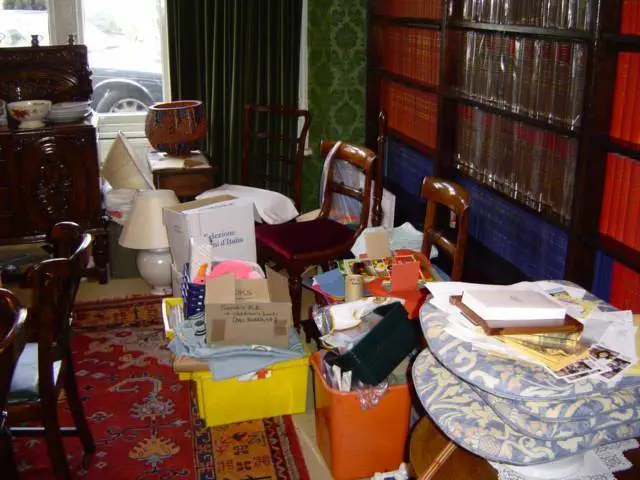
5. Contradictory Clutterholic
You are like 11% of Clare’s clients since 2001
A contradictory Clutterholic is so named because they say they want to clear their clutter yet all their actions and decisions are based on keeping all their clutter so they don’t have to make decisions about their future.
They are usually in denial that they have a problem with clutter and instead see it as a problem with time, organisation, space etc.
What you will see:
Clutter in 3 or more rooms plus the kitchen or bathroom.
How much clutter?
50% – 75% – surfaces, drawers, under furniture, cupboards stuffed and disorganised, all over the floor, all surfaces and to waist height.
What their friends and family will see:
They will be aware that they have a clutter problem because it will be visible in the rooms they see, although the clutterholic may have stopped inviting friends and family into their home.
They believe their biggest problem with dealing with their clutter is:
Lack of time, lack of storage space and lack of organisation, difficulty in making decisions, support, the believe that their things might come in useful, seeing the things in their clutter in terms of practicality rather than financial value.
Where most of the clutter comes from:
Grocery Shopping: They go grocery shopping more than once a week and don’t stick to a list and impulse buy
General Shopping: They go once a week without a list and impulse buy things
Online Shopping: They will surf the internet and impulse buy items they don’t need or use
Why they may be disorganised:
Most things don’t have a clearly defined home but the owners believe that’s because they don’t have enough storage space or time to tidy up and put things away.
Why they struggle with keeping areas clear of clutter:
They rarely do things like household cleaning because there are so few surfaces that can be cleaned.
Paperwork Clutter:
They probably open their post every week and deal with their paperwork every couple of months.
Financial Clutter:
They don’t have a routine of checking their financial paperwork against their shopping receipts, they don’t keep receipts, and they don’t know their monthly financial situation or what they spend their money on.
What they want:
They want a solution that will enable them to have more space and be organised without having to let go of anything.
What they are likely to say about their clutter:
I want to learn how to do this myself but I don’t want to have to actually let go of much of it and I don’t have time to do it myself
How they often feel about their clutter:
Denial / A fear of acknowledging the problem by acknowledging that they’re not succeeding at clearing it on their own / A fear of life without the clutter / A conflict between what’s right for them and what’s right for other people.
The most common type of clutter they have:
Anything from the past, present bought in anticipation of being used in the future
The most common type of help they try before coming to Clutter Clearing:
Storage, Organisational Expert, Self Storage (when the expert doesn’t do it all for them quickly enough).
Will the 7 Step Clutter Clearing Programme Help?
Yes – Step 1, 2, 3, 4 and 5 to help get into a routine of controlling and maintaining their conveyor belt, clear the backlog, learn how to organise their home and deal with the sentimental items in their clutter.
How much of the persons time will it take?
Step 1 = 1 hour 2 days a week
Step 2 = 1 hour 5 days a week
Step 3 = 1 hour 5 days a week
Step 4 = 1.5 hours 5 days a week
Step 5 = 2 hours 5 days a week
How long does it usually take them to Clear their Clutter?
12 -18 months
6. Defiant Clutterholic
You are like 9% of Clare’s clients since 2001
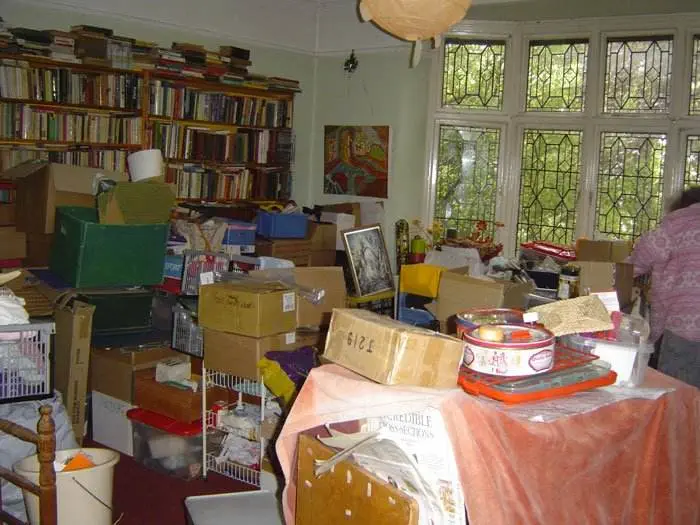
A Defiant Clutterholic is so named because they are resistant to letting go of any clutter, citing what they believe it’s worth – even when experts tell them it’s not worth what they believe it’s worth – and believing that they need it.
They will justify keeping their clutter with 101 reasons, and will fill their time with the associated to-do list (finding the right home / mending things / learning how to sell things on the internet) to avoid accepting that they need to reduce the amount of ‘stuff’ they have if they want more space in their home.
What you will see:
Clutter in nearly all their rooms plus the kitchen or bathroom.
How much clutter?
75% – surfaces, drawers, under furniture, cupboards stuffed and disorganised, all over the floor, all surfaces and to waist height. Only able to use a small area of the furniture or space e.g. only sleep on half a bed, only sit on one seat on the sofa, only sit on one dining room chair and have to move clutter to use any part of the dining room table.
What their friends and family will see:
They will be aware that they have a clutter problem because it will be visible in the rooms they see, although the clutterholic will probably have stopped inviting friends and family into their home.
They believe their biggest problem with dealing with their clutter is:
Lack of time, lack of storage space and lack of organisation, difficulty in making decisions, support, the believe that their things might come in useful, seeing the things in their clutter in terms of practicality rather than financial value and insisting they get that value back / out of their things.
Where most of the clutter comes from:
Grocery Shopping: They go grocery shopping more than once a week, don’t stick to a list and impulse buy
General Shopping: They go more than once a week without a list and impulse buy things
Online Shopping: They will surf the internet at least twice a week and impulse buy items they don’t need or use
Why they may be disorganised:
Most things don’t have a clearly defined home but the owners believe that’s because they don’t have enough storage space or time to tidy up and put things away.
Why they struggle with keeping areas clear of clutter:
They rarely do things like household cleaning because there are so few surfaces that can be cleaned.
Paperwork Clutter:
They probably open their post every week and deal with their paperwork every couple of months.
Financial Clutter:
They don’t have a routine of checking their financial paperwork against their shopping receipts, they don’t keep receipts, and they don’t know their monthly financial situation or what they spend their money on.
What they want:
They want a solution that will enable them to keep everything, have more space and not require any time or effort to implement or maintain.
What they are likely to say about their clutter:
I don’t have time to deal with it all or learn how to do it myself because I need to deal with it quickly and have someone help me do it for me so I can concentrate on keeping on top of it.
How they often feel about their clutter:
Denial / shame / fear of acknowledging the problem by acknowledging that they’re not succeeding at clearing it on their own / A fear of life without the clutter / A conflict between what’s right for them and what’s right for other people.
The most common type of clutter they have:
Anything from the past, present bought in anticipation of being used in the future
The most common type of help they try before coming to Clutter Clearing:
Storage, Organisational Expert, Self Storage (when the expert doesn’t do it all for them quickly enough).
Will the 7 Step Clutter Clearing Programme Help?
Yes – Step 1, 2, 3, 4 and 5 to help get into a routine of controlling and maintaining their conveyor belt, clear the backlog, learn how to organise their home and deal with the sentimental items in their clutter.
How much of the persons time will it take?
Step 1 = 1 hour 2 days a week
Step 2 = 1 hour 5 days a week
Step 3 = 1 hour 5 days a week
Step 4 = 1.5 hours 5 days a week
Step 5 = 2 hours 5 days a week
How long does it usually take them to Clear their Clutter?
15 – 18 months.
7. Obsessive Compulsive Hoarder
You are like 9% of Clare’s clients since 2001
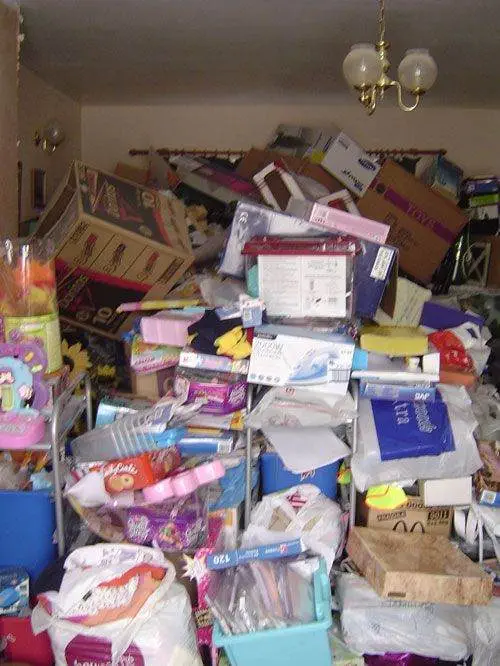
Obsessive Compulsive Hoarding is recognised as being more than just a behaviour and is now recognised as a disorder in the latest edition of the Diagnostic and Statistical Manual of Mental Disorders.
What you will see:
Clutter in all rooms and corridors of the home
How much clutter?
75% – 100% – surfaces, drawers, under furniture, cupboards stuffed and disorganised, all over the floor, all surfaces and to waist height. Only able to use a small area of the furniture or space e.g. only sleep on half a bed, only sit on one seat on the sofa, only sit on one dining room chair and have to move clutter to use any part of the dining room table. Clutter stacked floor to ceiling, wall to wall and can’t open the door. Like a maze with a small math through it, windows blocked, no light can get in.
What their friends and family will see:
They will be aware that they have a clutter problem because it may be visible from outside the home with the clutter in the windows and outside areas often cluttered.
They believe their biggest problem with dealing with their clutter is:
Lack of time, lack of storage space and lack of organisation, difficulty in making decisions, support, the believe that their things might come in useful, seeing the things in their clutter in terms of practicality rather than financial value and insisting they get that value back / out of their things, not wanting to ‘waste’ anything. They often have an extreme emotional attachment and memories of things in their clutter.
Where most of the clutter comes from:
Grocery Shopping: They go grocery shopping when they need to because they don’t have much space to store it.
General Shopping: They go when they feel like it and often pick up leaflets, knick nacks etc.
Why they may be disorganised:
There are no clearly defined homes for anything yet the hoarder will believe they can find things if they need to.
Why they struggle with keeping areas clear of clutter:
They don’t get rid of anything – not even empty tins, packets, newspapers that are years old etc.
Paperwork Clutter:
They probably don’t open their post regularly.
Financial Clutter:
They don’t have a routine of checking their financial paperwork, receipts will be kept but added to the clutter, and they don’t know their monthly financial situation or what they spend their money on.
What they want:
They don’t want a solution because for them it’s not a problem.
What they are likely to say about their clutter:
It’s my stuff and not affecting anyone else other than me so why do I need to clear it?
How they often feel about their clutter:
Denial / A fear of change / A fear of life without the clutter.
The most common type of clutter they have:
Anything from the past, present bought in anticipation of being used in the future, and anything that doesn’t have a financial value.
The most common type of help they try before coming to Clutter Clearing:
Nothing.
Will the 7 Step Clutter Clearing Programme Help?
No.
They need a bespoke 7 Step Clutter Clearing Programme that includes:
A home assessment to make sure they are suitable for the programme
Weekly half day home visits from Clare
Weekly 1 hour telephone calls with Clare
Weekly counselling / therapy sessions for the duration of the programme to deal with the mental clutter
At least one support worker / family member / friend who can visit inbetween the weekly home visits
How much of the persons time will it take?
Step 1 = 1 half day with Clare and a support worker + 1 hour telephone call + 1 hour therapy / counselling session a week
Step 2 = 2 half days (1 with Clare, 1 with a support worker) + 1 hour telephone call + 1 hour therapy / counselling session a week
Step 3 = 4 half days (1 with Clare, 3 with a support worker) 1 hour telephone call + 1 hour therapy / counselling session a week
Step 4 = 5 half days (1 with Clare, 4 with a support worker) + 1 hour telephone call + 1 hour therapy / counselling session a week
Step 5 = 6 half days (1 with Clare, 5 with a support worker) + 1 hour telephone call + 1 hour therapy / counselling session a week
How long does it usually take them to Clear their Clutter?
18 – 24 months doing a minimum of 2 hours for 5 days a week.

